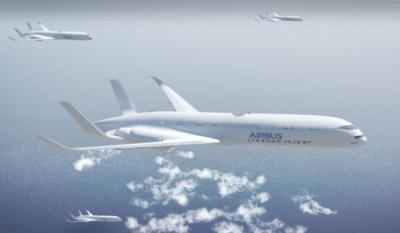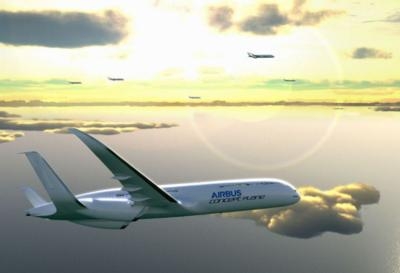Foresees A Future With More Flights, Fewer Emissions And Quicker Passenger Journey Times
What will commercial aviation look like it 2050? While no one can truly know for sure, Airbus has put forth its most recent installment of the Future by Airbus, its vision for sustainable aviation in 2050 and beyond, and for the first time the vision looks beyond aircraft design to how the aircraft is operated both on the ground and in the air in order to meet the expected growth in air travel in a sustainable way.

“Our engineers are continuously encouraged to think widely and come up with "disruptive" ideas which will assist our industry in meeting the 2050 targets we have signed up to," said Charles Champion, Executive Vice President Engineering at Airbus. "These and the other tough environmental targets will only be met by a combination of investment in smarter aircraft design and optimizing the environment in which the aircraft operates. That is why our latest Future by Airbus Smarter Skies concepts focus on not just what we fly but, how we may fly in 2050 and beyond.”
The report says that if the Air Traffic Management (ATM) systems and technology on board today's aircraft were optimized, Airbus research based on recent data suggests that flights in Europe and the US could on average be around 13 minutes shorter, and flights in other parts of the world could be shorter too. Assuming around 30 million flights per year, this would save around 9 million tons of excess fuel annually, which equates to over 28 million tons of avoidable CO2 emissions and a saving of 5 million hours of excess flight time. Add to this new aircraft design, alternative energy sources and new ways of flying and you could see even more significant improvements.
The Future by Airbus concentrates on just that, and the Smarter Skies vision consists of five concepts which could be implemented across all the stages of an aircraft’s operation to reduce waste in the system (waste in time, waste in fuel, reduction of CO2). These include:

Aircraft take-off in continuous 'eco-climb'. Aircraft launched through assisted take-offs using renewably powered, propelled acceleration, allowing steeper climb from airports to minimize noise and reach efficient cruise altitudes quicker. As space becomes a premium and mega-cities become a reality, this approach could also minimize land use, as shorter runways could be utilized.
Aircraft in free flight and formation along ‘express skyways’. Highly intelligent aircraft would be able to “self-organize” and select the most efficient and environmentally friendly routes (“free flight”), making the optimum use of prevailing weather and atmospheric conditions. High frequency routes would also allow aircraft to benefit from flying in formation like birds during cruise bringing efficiency improvements due to drag reduction and lower energy use
Low-noise, free-glide approaches and landings. Aircraft allowed to take free glide approaches into airports that reduce emissions during the overall decent and reduce noise during the steeper approach as there is no need for engine thrust or air breaking. These approaches would also reduce the landing speed earlier which would make shorter landing distances achievable, and require less runway.
Low emission ground operations. On landing aircraft engines could be switched off sooner and runways cleared faster, ground handling emissions could be cut. Technology could optimize an aircraft’s landing position with enough accuracy for an autonomous renewably powered taxiing carriage to be ready, so aircraft could be transported away from runways quicker, which would optimize terminal space, and remove runway and gate limitations.
Powering future aircraft and infrastructure. The use of sustainable biofuels and other potential alternative energy sources (such as electricity, hydrogen, solar etc) will be necessary to secure supply and further reduce aviation’s environmental footprint in the long term. This will allow the extensive introduction of regionally sourced renewable energy close to airports, feeding both aircraft and infrastructure requirements sustainably.

Airbus is already working on a number of innovative solutions today to meet the challenges of sustainable aviation in the future, whether it be the development and use of alternative fuels; investment in aircraft design; or in supporting more efficient ATM. Airbus is also one of the major actors of the NextGen and SESAR programs - which seek to enhance the performance of the ATM system through a better use of aircraft capabilities, changes in infrastructure and organization. These new capabilities are designed to reduce traffic congestion and delays, will allow more direct routes, better flight profiles, and should help reduce the cost of air navigation services through advanced communications and technologies.
“We know people want to fly more in the future and our forecasts support this. We also know that they don’t want to fly at any cost,” says Charles Champion. "Our focus ... is on meeting this continuous growth in demand, keeping the passenger, our customers and the environment at the center of our thinking. The future of sustainable aviation is the sum of many parts and success will require collaboration amongst all the parties who are passionate about ensuring a successful prospect for aviation.”
(Images provided by Airbus)
 ANN's Daily Aero-Linx (04.16.24)
ANN's Daily Aero-Linx (04.16.24) Aero-News: Quote of the Day (04.16.24)
Aero-News: Quote of the Day (04.16.24) Airborne 04.10.24: SnF24!, A50 Heritage Reveal, HeliCycle!, Montaer MC-01
Airborne 04.10.24: SnF24!, A50 Heritage Reveal, HeliCycle!, Montaer MC-01 Airborne 04.12.24: SnF24!, G100UL Is Here, Holy Micro, Plane Tags
Airborne 04.12.24: SnF24!, G100UL Is Here, Holy Micro, Plane Tags Airborne-Flight Training 04.17.24: Feds Need Controllers, Spirit Delay, Redbird
Airborne-Flight Training 04.17.24: Feds Need Controllers, Spirit Delay, Redbird





